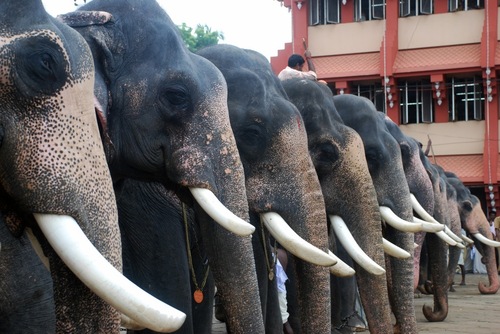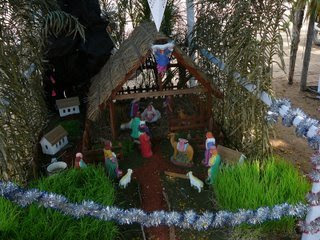188# Participate in the Thrissur pooram, April - May
Thrissur Pooram is called 'the pooram of all poorams' (festival). It is the biggest of all poorams held in Kerala state. The Thrissur pooram, is celebrated every year in the month of Medam (mid-April to mid-may) as per the malayalam calendar. While all poorams have a huge influence on surrounding neighborhoods and towns, few other festivals require their active involvement. Thrissur town plays host, for 36 hours from the wee hours of the pooram day, to one of the most largest collection of people and elephants. The richly decorated elephant, as seen during the Thrissur pooram, is now globally recognized, and its association with Kerala. On the pooram day, fifty (50) or more elephants pass through the very center of Thrissur town, the Vadakkunnathan temple. The main features of the pooram (festival) are these decorated elephants with their nettipattam (decorative golden headdress), beautifuliy crafted kolam, decorative bells and ornaments etc. Add to this is the panchavadyam, the rhythmic beating of the drum, and what would be a cacophony otherwise is turned into an organized but spontaneous symphony. The fireworks display in the early hours of the next day, rival shows held anywhere in the world, without even using many of the modern and newer pyrotechnics.
While India is considered to be between 5000 to 10000 years old, and many rituals, Hindu customs and festivals date back centuries, the Thrissur pooram is only about 200 or more years old. It was orchestrated by the then ruler of Cochin, Sakthan Thampuran or Raja Rama Varma, in 1798. Sakthan Thampuran, so known for his firm and decisive administration, decided to break tradition and create a venue for the temples belonging to his region to celebrate their pooram festival. Before the advent of Thrissur Pooram, the largest temple festival during summer in Thrissur thaluk was the one-day festival held at Arattupuzha, 12 km south of the city. Temples in and around Thrissur were regular participants of this religious exercise until they were denied entry by the chief of Peruvanam Gramam. The delay caused by the temples from Thrissur and Kuttanellur, was one of the reasons for denial. This caused the ThrissurNaduvazhi, the chief poojari of Vadakkunnathan, known as Yogadiripad and the Kuttanellur Naduvazhi started the pooram in Thrissur. This pooram started as an act of reprisal quickly lost its charm, after infighting between the two main Naduvazhis. It required the intervention of the ruler to get this right.
Thrissur Pooram is celebrated at of the Vadakkunnathan Temple, situated on a hillock (Thekkinkadu maidan) in the centre of the city, on the Pooram day in the month of Medom (April-May). Processions of richly caparisoned elephants accompanied by percussion ensembles from various neighbouring temples culminate at the Vadakumnathan temple. The most impressive processions are those Thriuvambadi Bhagavathy from the Thiruvambadi Sri Krishna Temple and the Paramekkavu Bhagavathi from Paramekkavu temple. The celebrations which last for over 36 hours includes parasol displays and firework shows.Sakthan Thampuran unified the 10 temples situated around Vadakkunnathan temple and organized the celebration of Thrissur Pooram as a mass festival. Sakthan Thampuran ordained these temples into two groups, Western group and Eastern group. The Western group as Thiruvambady consisting of Kanimangalam, Laloor, Ayyanthole, Nethilakkavu and the Thiruvambady temple, as the main one. The Eastern group called as Paramekkavu, consisting in addition to Paramekkavu temple, Karamukku, Chembukavu, Choorakottukavu and Panamukkamppilly. The pooram was to be centered around the Vadakkunnathan temple, with all these temples sending their poorams (the whole procession), to pay obeisance to the Shiva, the presiding deity. The Thampuran is believed to have chalked out the program and the main events of the Thrissur pooram festival. It is this historical background that determines the course of the pooram program and it is specifically the ruler's antipathy to the Brahmin aristocracy to open Thrissur pooram for the common man.
Vadakkunnathan is a mere spectator at this festival, lending its premises and grounds for the great event. The pooram (festival) is also well known for the magnificent display of fireworks. Fire works start in the early hours and the dazzling display last three to four hours. The Pooram Festival is celebrated by two rival groups representing the two divisions of Thrissur Paramekkavu and Thiruvambadivying with each other in making the display of fireworks grander and more colourful. Each group is allowed to display a maximum of fifteen elephants and all efforts are made by each party to secure the best elephants in South India and the most artistic and colourful parasols, which are raised on the elephants during the display. Commencing in the early hours of the morning, the celebrations last till the break of dawn, the next day.
The marvelous as well as magical effect of the Panchavadyam, a combination of five percussion and wind instruments is to be felt and enjoyed. Among the varieties of festivals celebrated in Kerala,Thrissur Pooram is the most thunderous, spectacular and dazzling. There are three temples participating in the event. It is an expression of popular fascination for sound and colour, and because of the pageantry, it appeals to all people. The images of the deities from all temples of the village are taken on elephants to the main temple. The climax of the festival is the exhibition of thirty elephants and the famous fireworks at 2.30 AM local time.
Adhering to the medieval Peruvanam tradition, the festival is confined to the temples of Devi (goddess) and Sastha (divine combination of Shiva and Vishnu). Ten deities from the neighboring temples pay obeisance to the presiding deiety of Thrissur.
Principle participants are Paramekkavu Bagavathi Temple and Thiruvambadi Sri Krishna Temple, close to the Vadakunnathan temple. Also participating and known as constituent Poorams are the suburban temples at Kanimangalam Sastha Temple at Kanimangalam, Pookkattikkara - Karamukku Baghavathy Temple at Karamukku near Chiyyaram, Choorakkottukavu Bagavathy Temple at Choorakkattukara, Laloor Baghavathy Temple at Laloor, Sree Karthyayani Temple at Ayyanthole, Nethilakkavu Bagavathy Temple at Neithilakkavu near Kuttoor, Chembukkavu Bagavathy Temple at Chembukkavu and Panamukkumpally Sastha Temple at Panamukkampilly near East Fort Thrissur for a total of eight deities. The sprawling Thekkinkadu maidan, encircling the Vadakumnathan temple, is the main venue of the festival and usually known as Thrissur Swaraj Round.
Courtesy : wikipedia





Comments